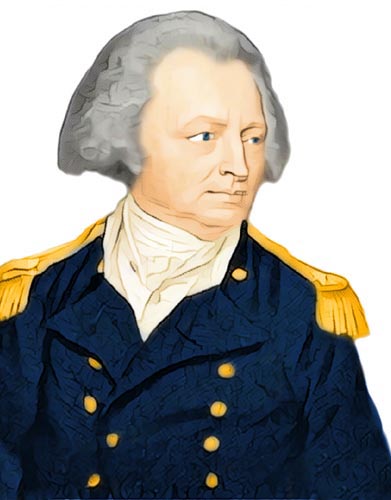 |
 |
|||
|
|
Sir George was the eldest son of the Rev. George Young of Bere Regis in Dorset, by his wife Eleanor, the daughter of Joseph Knowles. The Young family claimed descent from John Young of Buckhorn Weston, a Sheriff of Dorset in 1570. It is said that Young went to sea in the Namur with Edward Boscawen
in 1746, in which case it would seem that he went out to the East Indies with Boscawen in 1747, quitted the service there, and joined that of the East India Company. On 20 Dec. 1757 he was discharged with credit as a midshipman from the Prince of
Wales East Indiaman, and immediately entered on board the York as an able seaman with Captain Hugh
Piggot (1721–1792), and after six weeks was rated as a midshipman. In this capacity, he served at the
Siege of Louisbourg in 1758, during the Seven Years' War, where he commanded a boat at the cutting out of the Bienfaisant
of 64 guns, and the destruction of the Prudent of 74 guns, which was followed next day by the surrender of the place. An oil picture by Francis Swaine of this night
engagement was painted from Young's sketch. In 1759, he was, again with
Piggot, in the Royal William at the capture of Quebec. His passing certificate,
dated 3rd September 1760, mentions only the York and Royal William, in addition to his certified service under the East India Company. On 16th
November 1761, he was promoted to be lieutenant of the Orford, with Captain Marriot Arbuthnot, which, in February 1762, went out to the Leeward Islands in charge of
a convoy, took part in the Battle of Havana under Sir George Pocock, and continued on the Jamaica station
until the peace. Young was promoted to be a commander on 29th September 1768, served for some time on the West African station, where he was one of the explorers of the ancient
burial sites on the Peak of Teneriffe, and brought thence a mummy which
he presented to the library of Trinity College, Cambridge. In 1776, he went out to the East Indies in command of the Cormorant, from which, on 7th
November 1777, he was posted to the Ripon as flag-captain to Sir Edward Vernon, with whom he
took part in the Siege of Pondicherry in India, a Anglo-French engagement
related to the American Revolutionary War on 10th August 1778. Young was then sent home with despatches, received the usual compliment of
£500 to buy a sword and was appointed, in March 1779, to the William and Mary
yacht. In this ship, he took the Prince of Wales to the Nore Sandbank at
the mouth of the Thames when the King visited the Fleet under Sir Hyde Parker (1714–1782) after the
Battle of Dogger Bank during the Fourth Anglo-Dutch War on 5th August 1781.
Young was knighted on 24th August 1781. Afterwards, he was moved into the Catherine
yacht and, during the Russian armament of 1791, to the Zealous. On 4th July 1794, he became a rear-admiral, vice-admiral on 14th
February 1799, and admiral on 23rd April 1804, but had no service.
|
|||
| © Nash Ford Publishing 2013. All Rights Reserved. | ||||



 Adm. Sir George Young (1732-1810)
Adm. Sir George Young (1732-1810)